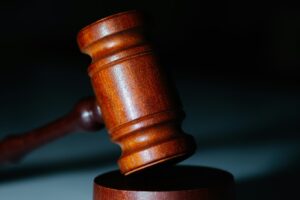by: Kathleen Kuznicki, Esq.
If you are considering getting a patent, you should be familiar with the items that must be included in a patent application. Below is a detailed outline of the material you will need to prepare to patent your new invention.
1. Background — You set the story for your invention
- Describe the field and what problem is being solved
- Describe how previously the problem was solved (if it was even previously recognized)
- Describe the deficiencies of the previous technology
- Didn’t actually solve the problem (it didn’t really work)
- Solved the problem, but inadequately; improvements are needed
- Solved the problem adequately, but not optimally; advantages are unrealized
- Evolving technologies create evolving problems that need evolving solutions
2. Summary of the Invention — Your invention:
- Solves the problem!!
- Improves upon the previous ways to solve the problem!!
- Has advantages that optimize solving the problem!!
- Builds upon the latest technology to solve the problem!!
- Is faster, smaller, less complicated, more cost effective, easier to make, easier to use, etc., and your invention does this all in a novel and non-obvious way!!!
3. Short Description of The Figures — these descriptions are essentially the captions you would give the individual figures.
4. Detailed Description
- Reinforce the important points made in the background and summary
- Describe all conceivable embodiments; basic, preferred, most preferred, etc.
- Describe the Figures in excruciating detail; describe every configuration and every element that comprises the configurations, describe how the elements cooperate to achieve a purpose;
- All elements must be labeled with numerals in the Figures
- Describe the invention from the broadest terms possible that achieve the intended function to the most specific elements that optimizes your invention
- Use non-limiting language as much as possible
- Use boilerplate language- e.g.-the invention is not limited to the embodiments disclosed
5. Figures
- Follow the Standards For Drawing outlined in 37 CFR 1.84
- Show different embodiments as examples-not limiting!!!
- Show your ideal embodiment(s) with all the necessary elements
- Use flow charts to enhance the understanding of methods or processes
- For physical items show differing views – front, top, side, bi-sectional to see the inside of the device, exploded to see the various parts, close-up of intricate configurations, etc.
- Every device/part/subpart must be labeled with a numeral and must be described
6. Abstract
- Summary of the Summary-problem that is solved and key features of the invention
- Words that would be used in a patent search; some systems only use title and abstract
Claims are the most important part of the application; they are what legally define the invention!
- Claims are what the examiner compares to the prior art (usually previous patents and patent applications, but can be anything in the public domain, such as journal articles, websites, etc.)
- Claims are to what a product will ultimately be compared to determine infringement; every feature/element/configuration defined in the claim must be contained in the product/process for a finding of infringement
- Individual claims are allowed to be only one sentence!! That is why they seem so convoluted!
- Must claim as patentable subject matter -any new and useful process, machine, manufacture, or composition of matter, or any new and useful improvement thereof
- Must not claim as non-patentable subject matter
- abstract ideas
- mental processes
- laws of nature
- algorithms
- physical phenomena
- no clear cut boundaries– latest court cases have only added to the confusion!!
- Must not claim as non-patentable subject matter
- Independent Claims
- Broadest definitions of the invention using the least amount of limitations
- Initial filing- trying to define only what is minimally necessary for a functional invention; what is adequate, not what is optimal (no bells and whistles)
- Use of generic descriptions as opposed to specifically defined features/elements
- Use of functional language as opposed to defining structure (if you can get away with it)
- Testing the broad boundaries of the invention vs. the prior art
- Dependent Claims
- Further refine your invention with claims of a more narrow scope
- Fall back positions if the independent claims are rejected or invalidated
- Additional limitations to further distinguish your invention from the prior art
- More specifically define features/elements, especially to define alternatives
- Additional features/elements that enhance or optimize your invention
- If defining a range – define a more and a more narrow scope to the range
- “picture claim”- very specifically defining an embodiment; usually the product to be sold; the most narrow claim and the least protective claim
*Claims are usually amended during the patent prosecution process to further clarify the invention or to further distinguish the invention from prior art references cited by the patent examiner. The final set of claims in the issued patent is used for infringement determinations.
Kathleen Kuznicki is a contributing writer to Exit Promise. Please visit www.exitpromise.com to view more articles by Kathleen.




